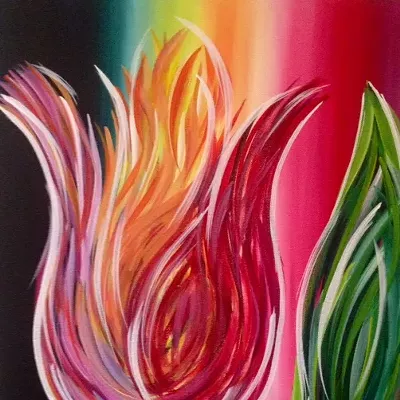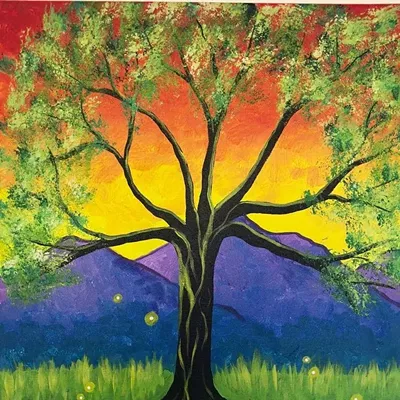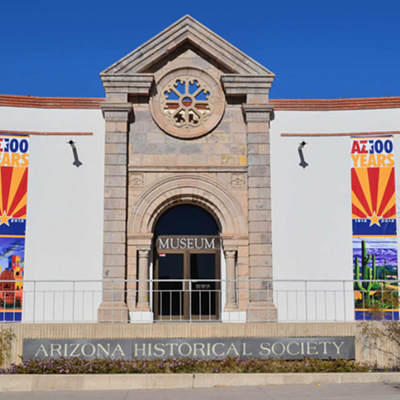Her best-known paintings draw their forms and colors from the ravishing landscape near Taos, where she was a regular visitor from the 1930s on, and settled permanently in 1946. But her paintings don't exactly portray the land as it is. As early as 1915, she began experimenting with a style that would come to be called organic abstraction, concentrating less on the subject itself and more on its shape, rhythm and emotional resonance.
But while O'Keeffe was charging off into the art frontiers, abandoning the realism she had learned at the Art Institute of Chicago, dozens of realist artists were in New Mexico, rendering the same land in a time-honored representational style. Serenading the Light: Painters of the Desert Southwest, a large and sumptuous touring show at the Tucson Museum of Art, resurrects scores of realist painters as forgotten today as O'Keeffe is celebrated.
The 80-some works in the show, including paintings, prints and drawings, are all from the private collection of painter Billy Schenck, who unabashedly declares that he's attracted to romantic imagery. With a few exceptions, the artists he collects worked in New Mexico in the first half of the 20th century, before what he calls the "influence of John Marin and the 'modernist painters,'" attracted to the state by O'Keeffe and others.
Despite this assertion, many of his artists coincided with the great influx of modernists into Taos, or came later, and here and there, they demonstrate a passing acquaintance with new ideas. Victor Higgins, for instance, tried out a little cubism in his 1932 oil portrait, "Spanish Woman (Maria Ignacia)." But by and large, they steadfastly stuck to realism.
The Schenck artists worked the same turf as O'Keeffe--the canyons, mountains, mesas, big skies and brilliant light of New Mexico--with obviously very different results. For some of the artists, a comparison is no contest. In 1911, a few years before O'Keeffe started producing brilliant watercolor abstractions inspired by the land, E.I. Couse was turning out "Call of the Flute," a cornball oil that has an Indian maiden in a lighted forest peering out at a handsome Indian flutist. A member of the Taos Society of artists, Couse may have known how to put paint to canvas, but he indulged in romantic hogwash, following a faux Indian storyline at least as old as "Hiawatha."
But other artists in the collection stand up robustly. In 1916, the year after O'Keeffe's modernist epiphany, when she declared "I decided to start anew," William R. Leigh painted the cheerful "Indian Woman With Pottery" in oil on board. More realist than romantic, the talented Leigh used to travel into Hopi to paint. His windswept, sunstruck "Indian Woman," an oil just 6 by 8 inches, has the freshness of bracing reality. The brilliant sun of the Hopi mesa lights up a golden dwelling beneath the bright blue New Mexico sky. To be sure, the young Indian woman has the picturesque butterfly hairdo so beloved of early photographers, but she's a real person, beaming a megawatt smile, a fine contrast to the cliché of the stoic Indian.
The divide between Couse and Leigh kind of sums up this show. It's exhibited in the many small rooms of the historic Fish House, and there are whole sections you can skip. One room, set up with a tiresome, continuously rolling video on a local cowboy artist, is full of silly, romanticized paintings of Native Americans. But much of the work, including some Indian portraits, is exceptional and beautiful. Many of these old Western artists were gifted painters, masters of their craft. Room after room is filled with landscape paintings that joyously serenade the Western light; the Western landscape is too monumental, too sublime, to let the kitsch in.
"Enchanted Mesa," an undated oil by Albuquerque artist Carl Redin, is a voluptuous but unfussy homage to the classic West: It's got gloriously colored clouds layer on layer; a mesa soaring skyward; low blue mountains on the horizon; a green-and-brown desert floor. Apparently painted in the great outdoors, in nice thick brushstrokes, Redin's work is a sensuous response to what he was actually seeing.
Clyde Forsythe, a native Californian, pushed the mesa genre in the direction of abstraction. A pair of paintings, each also named "Enchanted Mesa," are less portraits of the land than they are studies of color and shape. The Western skies and mesas easily lend themselves to such treatment, and Forsythe reduces them here to sleek geometric volumes and flat planes of color.
Collector Schenck is partial to the subgenre of autumnal New Mexico, and golden seasonal works fill one whole room. "Road to Chimayo," a 1927 oil by Sheldon Parsons, has the whole fall package: cottonwood foliage aflame, a pair of low-slung adobes, multi-color mountain peaks, curving dirt road, all suffused with a golden glow. Reminiscent of Thomas Hart Benton's regional realism, it's a little too much, a little too fussy.
Norma Bassett Hall handles the same subject much better. Her color woodblock print "October in Santa Fe" is tiny, only 10 inches high, but far more disciplined than Parsons' big showy painting. A native of Oregon, Hall includes most of the same autumnal elements, but she's stripped down the frippery and simplified. The result is compelling.
Another talented woman printmaker, Gene Kloss, specialized in velvety black and white aquatints. Originally from California, Kloss hired on with the Works Progress Administration, the only etcher on the agency's payroll in New Mexico. No wonder. Her prints are arrangements of sensuous volumes and few lines, depicting such events of Pueblo life as "All Saints Day Mass," 1934, and "Eve of the Green Corn Ceremony Domingo Pueblo," 1934. But her works are neither picturesque nor cloying. "Penitente Fires," from 1939, is a dramatic nighttime mix of mountains and men, lit up by the smoke from the flames of a religious rite.
Quite a few of the artists had a sideline in breathtaking pencil drawings. Edgar Payne, who like O'Keeffe studied at the Art Institute of Chicago, used a single pencil to create a marvelous variety of marks on the page, from shadings to lines both soft and hard. His fine drawings, including "Navajo Riders in Canyon de Chelly"--looking suspiciously like a famous Curtis photograph--are more interesting than his full-fledged paintings.
Maynard Dixon has two works in the show, a nude figure drawing and a remarkable landscape. The catalogue text rightly calls him "the Western artist that even people who don't particularly like Western art can take seriously." Deploying broad sensuous planes of color, Dixon can brilliantly sum up a place in a just a few shapes and strokes.
"Last Gleam" 1941, painted in Tucson, where Dixon lived for some years, is all by itself worth the price of admission. The blue Catalinas roll across the horizon, thunderclouds roar in from the east, and the creosotes below are ablaze with an Arizona day's last eerie light. Quick and deft, a marvel of color and simplicity, "Last Gleam" is as much about paint and shape as it is about this heated-up desert place. Surely even the crusty O'Keeffe would have approved.














